As a practitioner deeply invested in creating optimal outcomes for children, understanding the factors that influence developmental disorders like autism is crucial. A recent study titled Comparative study of the relationship between pregnancy and childbirth factors and autism in healthy children and children with autism offers valuable insights that can guide our approach to early interventions and preventive measures.
Key Findings from the Study
The study, conducted on 200 children in Isfahan, aimed to compare various pregnancy and childbirth factors between healthy children and those with autism. Here are some significant findings:
- Maternal and Paternal Age: A significant relationship was found between the ages of both parents at delivery and the likelihood of autism in children.
- Gestational Age and Birth Intervals: The gestational age at delivery and the interval between pregnancies were also significant factors.
- Socioeconomic Status and Place of Residence: Economic status and living conditions were significantly different between the two groups.
- Multiple Pregnancies and Neonatal Health: Factors such as multiple pregnancies, neonatal sex, and diseases in infancy were linked to autism.
Implications for Practitioners
These findings underscore the importance of considering a range of factors when assessing the risk of autism in children. As practitioners, we can implement the following strategies to improve outcomes:
- Early Assessment: Utilize comprehensive screening tools to assess parental age, socioeconomic status, and neonatal health during early consultations.
- Parental Guidance: Educate parents about the importance of optimal birth intervals and the potential risks associated with advanced parental age.
- Targeted Interventions: Develop tailored intervention plans for families identified as high-risk based on these factors.
Encouraging Further Research
While this study provides valuable insights, it also highlights the need for further research. Future studies could explore additional factors such as genetic predispositions, environmental influences, and parental health conditions.
By staying informed and continuously updating our practices based on the latest research, we can significantly enhance the developmental outcomes for children under our care.
To read the original research paper, please follow this link: Comparative study of the relationship between pregnancy and childbirth factors and autism in healthy children and children with autism.










